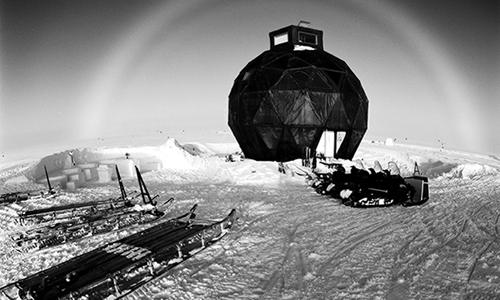Martin Skrydstrup
Letter from the Field, June 2010
A Cold Northern Light – Conducting Fieldwork on the Science of Ice
After several days of impatient waiting in worn-down military style living quarters called KISS (Kangerlussuaq International Science Support), in Greenland, the FO manager (field operations) calls to a long expected briefing at 9AM. I gather with the 12 other climate scientists selected for this flight mission to the NEEM research base in North-West Greenland: “Listen up,” the FO says, “weather is improving and we expect take off at noon – if conditions remain stable! So you’re not off the hook any longer and now in stand-by position” Everyone are excited and relieved and I am reminded how important the weather is for climate research. Three hours later we are airborne and on our way to the NEEM base in a US Air Force Hercules carrier – the only aircraft in the world capable of lifting several tons of heavy cargo to the middle of the Greenland Ice Sheet – and get away again.

On the plane the engine noise makes conversation impossible. I am allowed into the cockpit, where the second pilot explains me everything about the relation between fuel consumption, altitude and speed all while the first pilot is reading a magazine about Harley-Davidson motorbikes. Suddenly, a small black needle head appears on the ice sheet below, then clusters of red dots – the NEEM camp is 6km below us in splendid isolation. As the in-flight to the NEEM camp begins and I make my way back to my seat, I am thinking that this is one of the most isolated communities on Earth, completely inaccessible. What a rare privilege to be among the very few allowed into this ice coring community and the first anthropologist to conduct fieldwork in such a camp. As the plane touches the NEEM Apron and the camp population greets us, I am exhilarated.

After two weeks in camp, where I have assisted the cook in the main dome and helped out everywhere I could in the drilling and science trench, I am slowly getting familiar with the camp and its population of 32. The North Greenland Eemian Ice Drilling - NEEM - is an international ice core research project aimed at retrieving an ice core reaching back through the previous interglacial, the Eemian. The Eemian was about 5C warmer than present, which means that reconstructing this climatic period holds tremendous significance for science based action in a future of global warming. In the drilling trench, they feel confident that they now “are in the Eemian”, as they say.
Tonight a science meeting was held in the main dome after dinner, where many of the analyses of the ice core performed in camp were presented: Model results of the Greenland ice sheet evolution, methane gas concentrations of the glacial period, bag-mean water isotopes, DEP (Dia-electric properties of the ice core) and linescan intensity profiles. Currently, measurements show a “triple-peaked Eemian,” but this is still an open question of interpretation. As I head out of the Dome and towards my freezing Weatherport Tent, I feel I am fully emerged in the making of science in a vast time machine. We are literally drilling deep to foretell our common future in the Anthropocene – being part of this endeavor is what keeps me warm in my sleeping bag on the Greenland Ice Sheet.

Good night from NEEM,
Martin Skrydstrup
